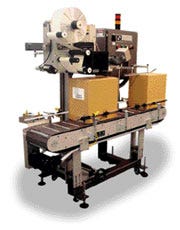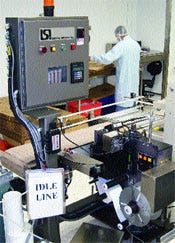Pharmaceutical labeling 741
In 2000, a major pharmaceutical company (MPC) located in the Midwestern U.S. initiated a labeling standardization project in seven of its manufacturing plants. Since that time, it has successfully installed, validated and placed into production a total of 70 new and/or upgraded systems to print and apply bar-coded labels to corrugated shipping cases. The thermal-transfer label applicators used for the project, supplied by Labeling Systems, Inc., are either single- or dual-head units applying one or two labels to each case at speeds of 10 to 30 labels/min. The applicators are operating over an Ethernet

connection, with bar-code label formats downloaded from a network. The systems are integrated into existing production lines and have the capability of bar-code scanning and confirming as many as three label bar codes simultaneously. The majority of the systems utilize three computer software programs to: 1) retrieve label formats, 2) interface with the scanners, PLCs, PC displays and reject mechanisms, and 3) print labels.
MPC chose thermal-transfer technology because, unlike ink-jet or laser printing, it is the only technology that can consistently print multiple lines of American National Standards Institute (ANSI) Grade A-quality bar-code and alphanumeric print with a single printhead. This produces higher read rates in-house during 100-percent-electronic verification. The result is less production rework downtime due to product mislabeling and higher first read-rate scanning by the customer. This translates into lower costs for MPC, the distributor and the customer.
To select the best label applicator vendor, MPC developed a list of selection criteria and then conducted a formal equipment operational comparison between six of the world's leading label applicator companies. Key reasons why MPC selected Labeling Systems, Inc. (LSI) include:
1) Labeling Systems, Inc. and its distributor, NuQuest Print Solutions, were better able to demonstrate and communicate a thorough understanding of the mechanics and electronics of their printhead applicator and print engine than the competition, which is a critical component of high-level customer support;
2) NuQuest Print Solutions is one of the fastest-growing label converters, using the latest printing technology to produce some of the highest-quality preprinted labels and providing some of the highest-quality blank labels in the U.S.;
3) The applicator combined the smallest footprint with the use of high-quality, high-strength, welded square anodized aluminum structural tubing construction with locking printhead mounting adjustments;
4) Labeling Systems, Inc. utilized MPC-approved high-quality off-the-shelf pneumatic, electronic and mechanical components;
5) The system required the least amount of time to replace rolls of labels and ribbon, as well as the least number of idler and drive rollers;
6) All of the pneumatic and electronic components are readily accessible for easy replacement and troubleshooting;
|
The labeling system computer is networked to a server for automatic downloading of label formats, which are retrieved by work order entered by the operator. |
7) Labeling Systems, Inc. demonstrated the most on-the-spot flexibility and creativity in its approach to equipment design in response to a proposed application challenge with space constraints;
8) The label applicator was the most robust unit tested and can handle the widest range of label sizes (333 in. to 3.5313 in.);
9) Labeling Systems, Inc. is fourth in the number of print-and-apply systems sold in the U.S.; and
10) Labeling Systems, Inc. is able to provide in-plant technical support for equipment outside the U.S., which was critical in this case, because some of the plants where systems were installed are outside of the U.S.
Units comply with FDA regulations
Steve Sylvander, equipment division manager at NuQuest Print Solutions, recommended Labeling Systems, Inc. to MPC because of the superior quality of the electrical and mechanical components used in Labeling Systems, Inc.'s label-applicator construction. One such component is the high-volume vacuum fan for holding the label on the applicator pad after it is dispensed. This is more cost-effective and reliable than the venturi-style vacuums provided by Labeling Systems, Inc.'s competitors. Labeling Systems, Inc. also utilizes PLC manufacturers that provide state-of-the-art communication devices like DeviceNet, Profibus, Net ENI Modules, and compact human/machine interfaces. Says Sylvander, "By utilizing off-the-shelf components, Labeling Systems, Inc. allows customers to upgrade systems to incorporate linear, 2D laser and RFID bar-code scanners, vision systems, rejection stations that interface to HMIs, and PCs. In addition, PLCs can be linked to existing warehouse management software or ERP software to provide real-time warehouse inventory and product tracking data."
Sylvander also mentions that the need for MPC to comply with FDA regulations, such as 21 CFR Part 11, required electronic batch records to be accessed and cleared. NuQuest performed factory acceptance testing at Labeling Systems, Inc. and validation at the MPC plants to ensure that the label-applicator systems and all software packages involved were 100-percent-compliant. "Most large pharmaceutical companies also have internal specifications that are written into the design qualification and need to be followed all the way through the project with audit trails," says Sylvander.
NuQuest was the systems integrator and assisted in the Visual Basic software development, as well as equipment installation and validation at all plants. By working closely with the dedicated support staff of information systems personnel in each of the plants, NuQuest demonstrated a commitment to excellence that has created a trusted partnership with MPC. It has provided maintenance and training in all seven manufacturing plants primarily during off-shift hours, (7 p.m. to 5 a.m.), due to three-shift production operations. Its training efforts have been highly successful as evidenced by the excellent care that the printhead, which is the highest-wear, most costly component of the print engine, is receiving. Recent reports from the plants have printhead life exceeding the warranty by seven to nine times.
The labeling systems are similar at all seven plants. To achieve this consistent functionality, Labeling Systems, Inc. and NuQuest were required to demonstrate flexibility and creativity. They responded to individual plant requirements by providing the option of either Sato or Zebra print engines and either Rockwell/Allen-Bradley or Siemens PLCs in their design. Common components consist of the rotary or linear label applicator, conveyor and operator  interface, computer monitor and keyboard, and shift-register tracking and rejection. The computer is networked to a server for automatic downloading of label formats, which are retrieved by a work order entered by the operator using the label-retrieval software. Access to this software is controlled through a combination of password and electronic badge swipe. As a further check, a second operator is required to scan his/her badge to confirm that the correct work order has been entered. The format is then printed using Easylabel print software from Tharo Systems, Inc.
interface, computer monitor and keyboard, and shift-register tracking and rejection. The computer is networked to a server for automatic downloading of label formats, which are retrieved by a work order entered by the operator using the label-retrieval software. Access to this software is controlled through a combination of password and electronic badge swipe. As a further check, a second operator is required to scan his/her badge to confirm that the correct work order has been entered. The format is then printed using Easylabel print software from Tharo Systems, Inc.
The Labeling Systems, Inc. systems use a Pentium III or higher computer to download label-copy format from the MPC work order to the print engine using Easylabel software. An Allen-Bradley MicroLogix 1500 PLC monitors I/O and communicates with upstream and downstream equipment. The system includes Datalogic fixed bar-code raster scanners to scan the bar codes on each label and compare them to the operator-entered work-order standards, and Banner SM312LV retroflective photoeyes that track the movement of the cartons through the system.
The Verification software resident in the PC and the PC digital I/O card links the bar-code scanner, slot reader, display and PLC together. The PLC controls the label applicator, the bar-code scanner, the printhead, the rejecter, the conveyor and the PC display.
Die-cut labels supplied by NuQuest are spaced approximately 1/8-in. apart on a roll of peelable pharmaceutical-grade label stock. They are pulled by the print engine's stepper-motor drive past the printhead, which prints up to three 10-mil UCC/EAN 128 linear bar codes on each label. These are designated as the primary, secondary and quantity bar codes. The system also prints human-readable information on the labels.
To start the operation, cartons are delivered to the labeler conveyor, which transports them to the application station. Blank, white, pressure-sensitive labels are automatically peeled from the paper backing and deposited onto the tamp pad, which holds the label in place using a fan-blower vacuum source. The unwind roll has a spring-loaded dancer/brake arm to provide constant unwind tension that maintains consistent print registration and minimizes print-engine stepper-motor inertial loading. After the label is removed, the paper backing is collected on a powered rewind roll coupled to a mechanical slip clutch. The carton passes a Banner sensor that triggers the label applicator, which extends and tamps the label onto the carton as it moves down the conveyor. The actuator design varies based on the application and is either linear, rotary or corner-wrap.
Following label application, a Datalogic scanner mounted to the labeling head scans the primary, secondary and quantity bar codes on the label and compares them to the bar codes required by the work order. The Verify BC software determines if the bar codes are unreadable or do not match the correct bar code, and if that occurs, the carton is rejected from the moving conveyor. A reject/verify photoeye confirms that the air cylinder has pushed the carton into the reject tote. Cartons with labels that are successfully scanned continue on to the palletizer.
More information is available:
Labelers: Labeling Systems, Inc., 201/405-0767. www.labelingsystems.com. Circle No. 203.
Labeler distributor, labels: NuQuest Print Solutions, 952/903-4500. www.nuquestlabel.com. Circle No. 204.
Scanner: Datalogic, Inc., 859/689-7000. www.datalogic.com. Circle No. 205.
Sensor: Banner Engineering Corp., 763/544-3164. www.bannerengineering.com. Circle No. 206.
PLC: Rockwell Automation/Allen-Bradley, 414/382-2000. www.ab.com. Circle No. 207.
PLC: Siemens Energy & Automation, Inc., 800/964-4114. www.sea.siemens.com. Circle No. 208.
Print engine: Sato America, Inc., 704/644-1650. www.satoamerica.com. Circle No. 209.
Printer: Zebra Technologies Corp., 847/634-6700. www.zebra.com. Circle No. 210.
Print software: Tharo Systems, Inc., 330/273-4408. www.tharo.com. Circle No. 211.
About the Author(s)
You May Also Like



